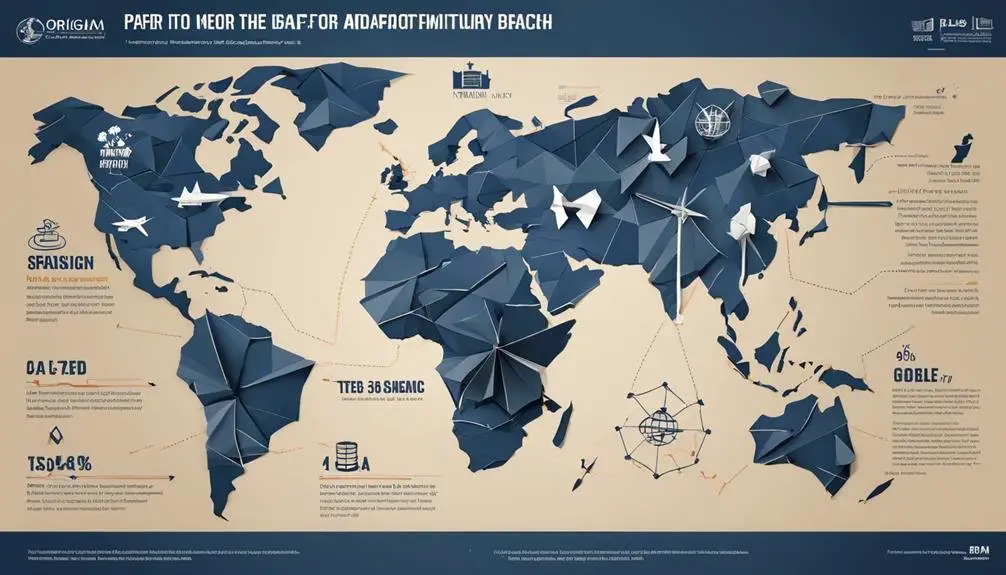The decision to join a military branch is profound, encompassing both personal aspirations and pragmatic considerations. Each branch – the Army, Navy, Air Force, Marine Corps, Coast Guard, and the emerging Space Force – presents a unique set of advantages and challenges.
From the allure of high enlistment bonuses and specialized training opportunities to the reality of rigorous living conditions and potential for hazardous duties, the balance of pros and cons is intricate. As we embark on a comparative analysis of these aspects, it becomes clear that the choice is not merely about selecting a military branch, but about aligning one's career ambitions with the values and opportunities each branch uniquely offers.
The ensuing discussion aims to illuminate these nuances, providing a foundation for informed decision-making.
Key Takeaways
- Each military branch offers unique career and training opportunities, from advanced technology to combat and maritime safety.
- Deployment rates and operational demands vary significantly across branches, affecting work-life balance and overseas experiences.
- Educational benefits and career development are substantial, with each branch providing specialized programs and growth opportunities.
- Challenges include physical demands, work-life balance, limited combat roles in some branches, and integration issues for the Space Force.
Army Advantages and Challenges
Exploring the Army's landscape reveals a blend of abundant career paths and rigorous demands, highlighting both its diverse opportunities and inherent challenges. With over 190 enlisted job specialties, the Army opens doors to a wide array of careers, from technical roles in information technology to combat positions on the front lines. This diversity allows individuals to find a niche that aligns with their interests and skills, offering a unique blend of professional development and personal fulfillment.
One of the significant advantages of serving in the Army is the unparalleled opportunities for leadership development and specialized training. Members are not only equipped with skills pertinent to their military duties but also gain competencies that are highly valued in civilian life. Furthermore, the Army's comprehensive educational benefits support continuous learning and career advancement.
However, the commitment to serve comes with its set of challenges. Army personnel may face longer deployments compared to other branches, increasing the time spent away from family and loved ones. The nature of military service also means a higher likelihood of exposure to combat situations, which can have lasting impacts. Additionally, the Army's emphasis on physical fitness and readiness demands a high level of personal discipline and resilience from its members. Despite these challenges, the strong sense of camaraderie and shared purpose fosters a supportive environment for those who choose to serve.
Navy: Opportunities and Drawbacks

Exploring the Navy as a branch of the military reveals a landscape rich with varied career opportunities, from aviation to healthcare, highlighting the branch's commitment to providing sailors with diverse paths for professional growth.
However, this comes with the caveat of frequent deployments, which can mean extended periods away from home, a significant consideration for those contemplating this career.
The balance between the broad spectrum of careers and the personal sacrifices required underscores the complexities of choosing a naval career.
Varied Career Paths
The Navy is renowned for its wide array of career paths, ranging from aviation and surface warfare to submarines and special operations, each offering its unique set of opportunities and challenges. These diverse roles provide sailors with extensive training and education opportunities, including access to specialized schools and certifications that are beneficial both inside and outside the military context.
However, these careers also come with drawbacks, such as the potential for long deployments at sea, which can lead to prolonged separation from family and challenging living conditions onboard ships. Nonetheless, serving in the Navy affords personnel the chance to travel globally, experiencing a variety of cultures and environments, while also engaging with advanced technology and maritime operations that offer unique career growth and specialization opportunities.
Deployment Frequency Concerns
Facing frequent deployments, Navy sailors often find themselves grappling with the dual-edged sword of unique travel opportunities and the strain of extended separations from family and home. The nature of the Navy's global mission means sailors can be away for 6-9 months at a time, often with little respite between deployments. This high operational tempo presents both challenges and rewards.
- Global Presence: Sailors experience diverse cultures and environments, broadening their horizons.
- Extended Deployments: Deployments can last from 6 to 9 months, leading to significant time away from loved ones.
- Unique Experiences: Access to experiences not available in civilian life or other military branches.
- Work-Life Balance: The challenge of maintaining relationships and personal commitments while fulfilling duty requirements.
Air Force Strengths and Weaknesses

Delving into the Air Force's profile, we observe a branch celebrated for its exceptional living conditions and educational opportunities, yet marked by a scarcity of direct combat roles. The Air Force distinguishes itself with superior living conditions, ensuring a high quality of life for its service members. Notably, it places a strong emphasis on educational opportunities and career development, fostering a culture of continuous learning and growth.
A pivotal strength of the Air Force lies in its advanced technological capabilities and its commitment to innovation. This focus positions the Air Force at the forefront of aerospace, intelligence, and cyber operations, offering a diverse range of job opportunities that cater to the digital and technological interests of modern service members.
However, a potential weakness of the Air Force is its limited scope in direct combat roles, especially when compared to branches like the Army or Marines. This limitation may deter individuals seeking a more traditional combat experience. Despite this, the Air Force's investment in technology and education, combined with its superior living conditions, presents a compelling proposition for those drawn to a military career aligned with the demands of the future.
Marine Corps: Benefits and Limitations

Exploring the Marine Corps reveals a branch deeply rooted in tradition, offering its members a unique blend of camaraderie, rigorous combat training, and a distinct sense of pride. This branch, known for its elite status within the military landscape, provides an environment where individuals can truly test their limits and grow in ways they might not have imagined. However, like any organization, the Marine Corps comes with its own set of challenges and limitations that potential recruits should consider.
- Strong Sense of Pride and Camaraderie: The Marine Corps fosters a profound sense of unity and belonging among its members, creating a tightly-knit community that supports one another in both professional and personal growth.
- Focus on Combat Training and Deployment: Marines are given ample opportunities to engage in advanced combat training, preparing them for various deployment scenarios and enhancing their tactical skills.
- Educational Benefits and Resources: While still available, educational benefits and resources in the Marine Corps may not be as extensive or accessible as those found in other military branches, potentially limiting further educational pursuits.
- Living Conditions and Physical Demands: The emphasis on combat readiness results in more austere living conditions and a demanding physical fitness regime, which can be challenging for some members.
Coast Guard Pros and Cons

Turning our attention to the Coast Guard, this branch offers a unique perspective on military service with its focus on maritime safety and security. Unlike its counterparts, the Coast Guard is primarily tasked with search and rescue missions and maritime security operations, which play a crucial role in the nation's safety and enforcement of maritime laws. These responsibilities afford Coast Guard personnel unparalleled opportunities for specialized training in areas such as law enforcement and environmental protection. This specialized training not only enhances their capabilities but also contributes significantly to global maritime safety.
Moreover, the Coast Guard's smaller size fosters a close-knit community feel, where members can enjoy a sense of camaraderie and belonging that is sometimes harder to find in larger branches of the military. This tight-knit atmosphere can lead to strong, lifelong bonds among service members.
However, the Coast Guard's distinct mission and smaller scale come with certain limitations. The branch has limited combat roles when compared to other military branches, which might be a drawback for those seeking extensive combat experience. Furthermore, due to its specific focus and operational scope, there are fewer opportunities for overseas deployment, limiting the chance for international experience that is readily available in larger branches.
Space Force: Innovations and Obstacles

The Space Force, established in December 2019, represents the newest frontier in U.S. military operations, focusing on the vast expanse of space. This branch is tasked with overseeing operations in space, encompassing satellite communication, missile warning systems, and global positioning systems (GPS), crucial for both military efficacy and civilian life. Despite being the latest addition to the U.S. military, the Space Force confronts unique challenges and offers unprecedented opportunities, highlighting both its innovative approach and the obstacles it faces.
- Innovations:
- Focuses on space operations, including the management and protection of satellites that are essential for communication, navigation, and missile warning systems.
- Offers unique career paths in space operations and satellite maintenance, catering to individuals fascinated by space and technology.
- Obstacles:
- Developing specialized training programs for personnel, ensuring they are equipped with the knowledge and skills necessary for space operations.
- Integrating with existing branches of the military, a significant challenge given the unique nature of space as a domain of operations.
The Space Force stands as a testament to the U.S.'s commitment to maintaining and expanding its dominance in space technology and security, ensuring the country's interests are protected in the final frontier.
Comparing Deployment Rates

Deployment rates among military branches serve as a crucial factor in understanding the operational tempo and commitments of the U.S. armed forces. Among these, the Marines stand out with the highest deployment rates, indicating a vigorous operational schedule that often sees its personnel deployed in various global hotspots. Similarly, the Army and Navy also experience frequent deployments. This is especially true for certain job specialties within these branches, where the nature of their missions demands a higher presence overseas. These roles are critical in maintaining the U.S. military's global reach and effectiveness.
Conversely, the Air Force and Coast Guard generally exhibit lower deployment rates compared to their counterparts. This does not imply a lack of operational commitment but reflects the different nature of their missions and the strategic requirements of their service. It's important to note that deployment rates can significantly vary based on operational demands and mission requirements. Within each branch, specialized units may face higher deployment rates than conventional units, reflecting the unique demands placed upon them. Understanding these nuances is key to appreciating the diverse operational landscapes each military branch navigates.
Conclusion
In conclusion, each branch of the United States military offers a unique set of advantages and challenges that cater to diverse career aspirations and personal preferences.
From the Army's extensive ground operations to the Space Force's cutting-edge technological focus, prospective service members have a wide array of options to consider.
Factors such as deployment rates, specialized training opportunities, and educational benefits must be carefully weighed against potential drawbacks like hazardous duties and tough living conditions to make an informed decision that aligns with one's long-term career goals and values.










